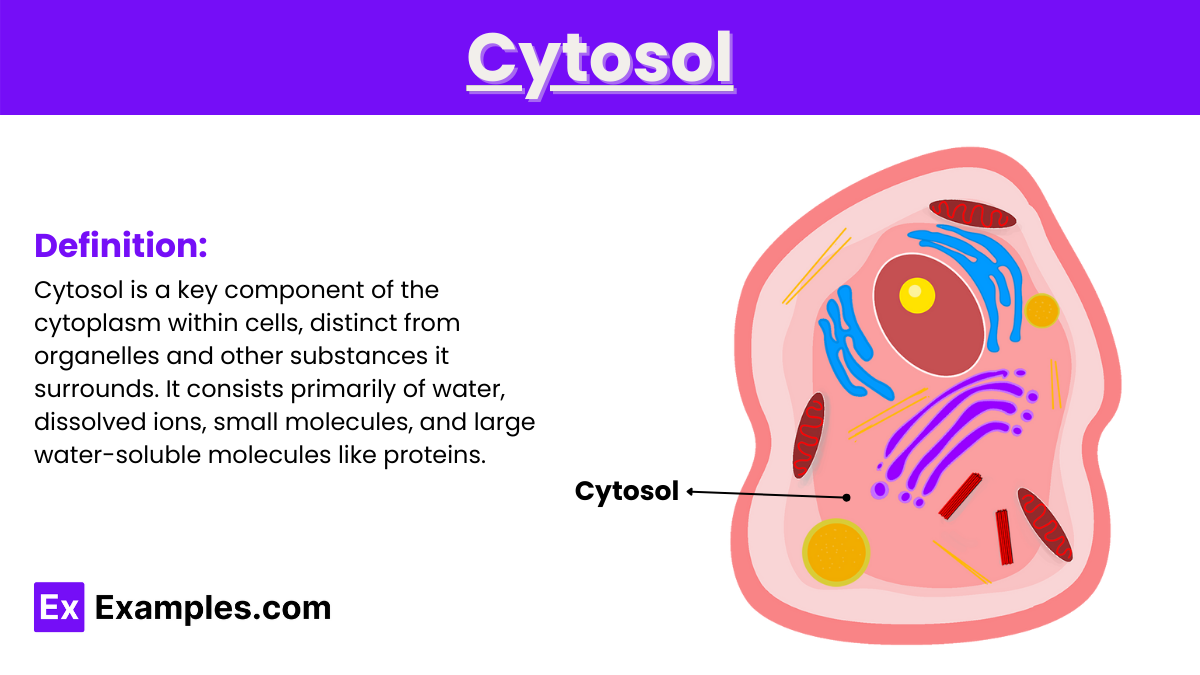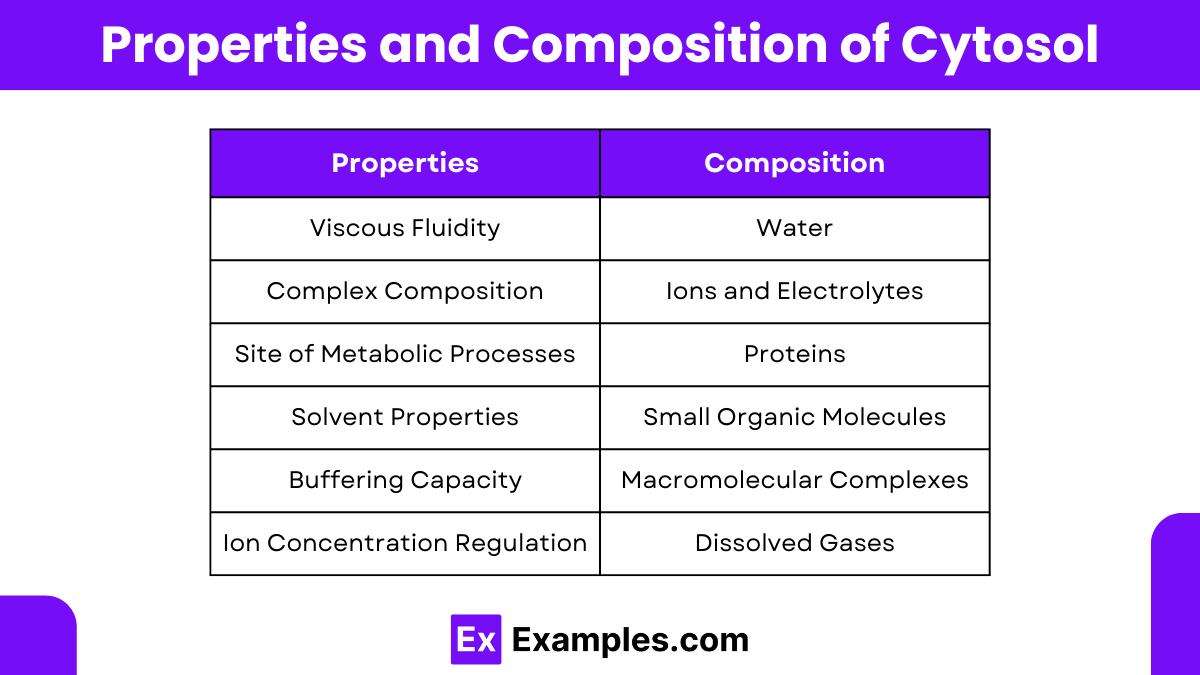Which of the following best describes the cytosol?
A membrane-bound organelle
The fluid component inside the cell but outside the organelles
The genetic material of the cell
The rigid outer layer of the cell


Cytosol forms the fluid portion of the cytoplasm in all cells, where numerous vital biochemical processes take place. This clear, jelly-like substance consists mainly of water, dissolved biomolecules, and suspended particles. It serves as the site for protein synthesis and metabolic activities, providing a medium for the components necessary for these processes to interact effectively. Understanding cytosol helps in grasping how cells function and respond to their environment, making it a fundamental topic in cellular biology. This article delves into the composition, functions, and importance of cytosol in maintaining the life processes within cells.
Cytosol is a key component of the cytoplasm within cells, distinct from organelles and other substances it surrounds. It consists primarily of water, dissolved ions, small molecules, and large water-soluble molecules like proteins. This fluid matrix fills the cell and serves as the site for many of the cell’s metabolic reactions.

The cytosol is the fluid component of the cytoplasm and is essential to numerous cellular processes. This complex mixture is mainly water but includes a variety of dissolved substances such as salts, organic molecules, and proteins. Here, we explore the key properties and composition of the cytosol in detail.

The cytosol is a fundamental component of the cell, occupying a central position in cellular anatomy. It is the liquid matrix found within cells, not confined by membranes. This fluid environment fills the cell’s interior, surrounding and suspending various organelles such as the mitochondria, endoplasmic reticulum, and nucleus.
The cytosol, often referred to as intracellular fluid, is a vital component of animal cells, constituting the liquid matrix that surrounds and supports cellular organelles. Composed primarily of water, salts, and various organic molecules, the cytosol facilitates numerous cellular processes, including protein synthesis, metabolic pathways like glycolysis, and intracellular transport mechanisms. This jelly-like substance is not only essential for maintaining the cell’s internal environment but also plays a crucial role in signal transduction and the movement of ions and molecules throughout the cell. As such, the cytosol is integral to the overall functionality and health of the cell, influencing both its structure and physiological behaviors.
The concept of cytosol, integral to our understanding of cellular biology today, has evolved through significant scientific discoveries and advancements. Here, we explore the historical timeline and key contributions that have shaped our knowledge of cytosol in animal cells.
The journey to understanding cytosol began in the 19th century with the development of cell theory. Scientists like Matthias Schleiden and Theodor Schwann posited that cells are the fundamental units of life, leading to microscopic explorations of cell components. However, the internal fluid of cells, now known as cytosol, wasn’t explicitly identified until later.
The advancement of microscopic techniques in the early 20th century allowed scientists to see cells in greater detail. With the invention of the electron microscope in the 1930s by Ernst Ruska, the internal structure of cells could be visualized, showing a complex environment of organelles suspended in a fluid matrix.
The term “cytosol” was coined in the mid-20th century as researchers began to differentiate between various parts of the cell’s interior. Before this, the term “cytoplasm” was used to describe the jelly-like material inside the cell, encompassing both the fluid and the organelles it contained. The distinction became necessary as biochemical studies advanced, leading to the understanding that the fluid portion of the cytoplasm (cytosol) and the organelles had different roles and compositions.
The cytosol, often termed as the cytoplasmic matrix, is a complex and dynamic fluid found inside cells, exclusive of the cell organelles and structures such as the nucleus, mitochondria, and endoplasmic reticulum. This aqueous solution is vital for the life of the cell, providing a medium in which cellular processes such as protein synthesis, metabolic activity, and signal transduction occur. Understanding the organization of the cytosol is essential for grasping how cellular activities are coordinated and regulated within the cell. Here, we explore the key components and characteristics of the cytosol.
The organization of the cytosol is far from static; it exhibits both compartmentalization and dynamism:
The cytosol plays a crucial role in cellular signaling and response mechanisms. It acts as a primary site for the signal transduction pathways that involve cascades of enzymatic reactions, often initiated by messengers such as calcium ions and cyclic AMP. Additionally, the cytosol interacts closely with other parts of the cell, particularly the cytoskeleton and membranes, to coordinate and execute various cellular functions.
Cytosolic proteins are proteins that are found in the cytosol, which is the liquid matrix that fills the cell and is separate from the cell organelles like the nucleus and mitochondria. These proteins play various roles, including cell signaling, metabolic pathways, and the maintenance of the cell’s structure.
Cytosol is the fluid component of the cytoplasm, facilitating metabolic activities and supporting cellular structures.
Cytoplasm includes cytosol and organelles, whereas cytosol is strictly the fluid matrix within the cell.
Organelles in the cytosol include mitochondria, ribosomes, and the Golgi apparatus, essential for cellular functions.
No, cytosol is not a bacteria; it is a component of the cell’s cytoplasm in eukaryotic and prokaryotic cells.
Cytosol is neither; it’s a liquid found inside the cells of both prokaryotes and eukaryotes.
Text prompt
Add Tone
10 Examples of Public speaking
20 Examples of Gas lighting
Which of the following best describes the cytosol?
A membrane-bound organelle
The fluid component inside the cell but outside the organelles
The genetic material of the cell
The rigid outer layer of the cell
What is the primary function of the cytosol?
To store genetic information
To provide a medium for metabolic reactions
To protect the cell from external damage
To generate ATP
Which of the following components is NOT found in the cytosol?
Enzymes
Ribosomes
Mitochondria
Ions
Cytosol differs from cytoplasm in that:
Cytosol includes the cell membrane
Cytoplasm includes organelles, while cytosol does not
Cytosol contains the nucleus
Cytoplasm is found outside the cell
The pH of the cytosol in most cells is typically:
Highly acidic
Highly alkaline
Neutral to slightly alkaline
Variable, depending on the cell type
Which process occurs in the cytosol?
DNA replication
Glycolysis
Photosynthesis
Electron transport chain
What structures are suspended in the cytosol?
Chromosomes
Organelles
Lipid bilayer
Extracellular matrix
The cytosol is primarily composed of:
Lipids
Carbohydrates
Proteins and water
Nucleic acids
Which ion is commonly found in the cytosol and plays a key role in cellular functions?
Chloride (Cl-)
Sodium (Na+)
Potassium (K+)
Calcium (Ca2+)
How does the cytosol contribute to cell shape and movement?
By storing genetic material
By providing a medium for glycolysis
By interacting with the cytoskeleton
By producing ATP
Before you leave, take our quick quiz to enhance your learning!

